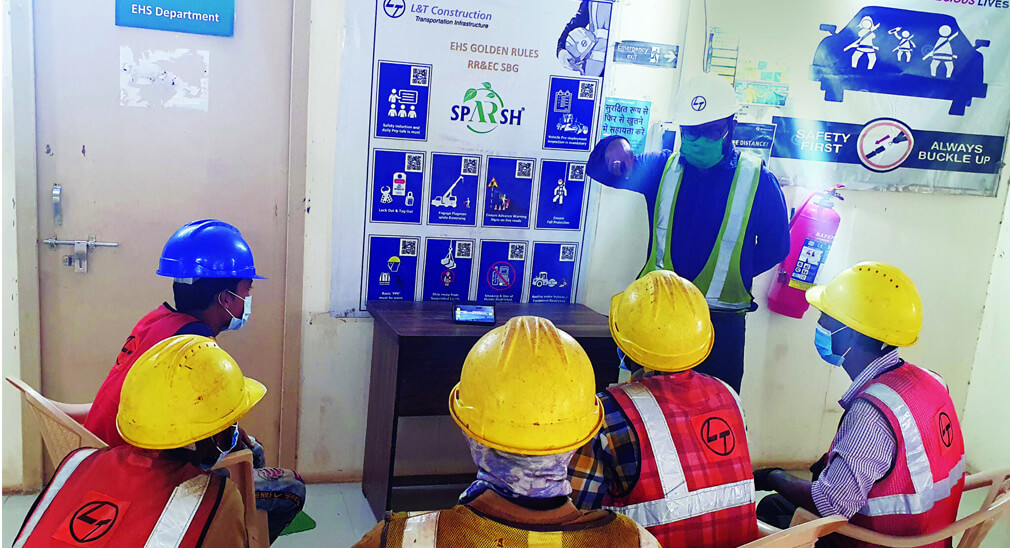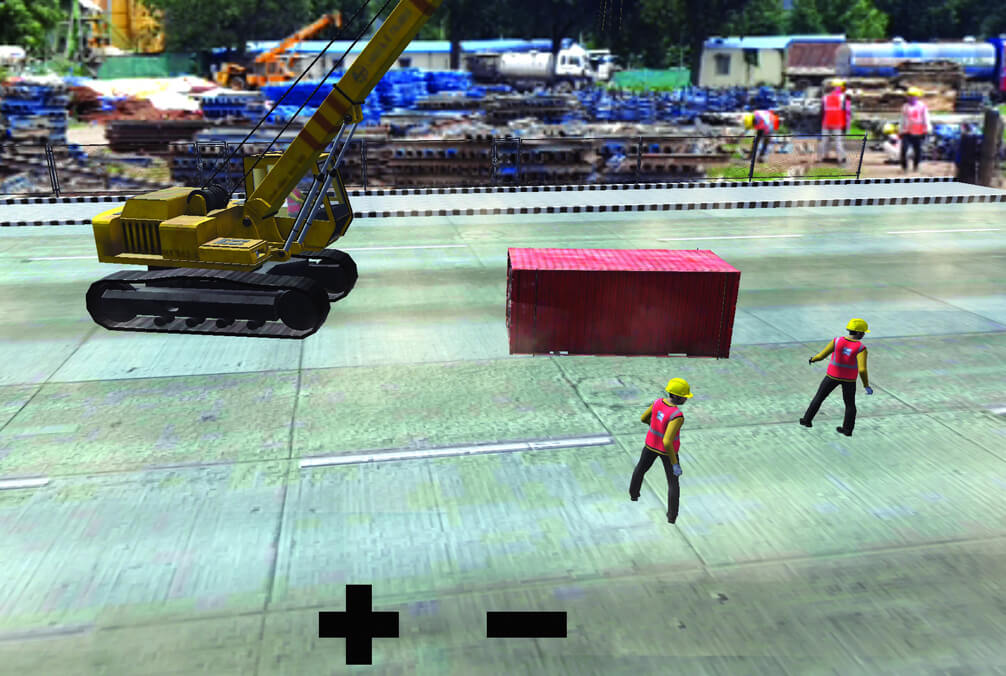More than EHS, training is a business imperative
It is often said that a system is only as strong as its weakest link. In a construction set-up, an untrained employee or workman can be that weakest link that undermines all the good that others do. With projects increasingly becoming bigger, more complex with more stringent timelines, a small bit of inefficiency in the system can rapidly snowball into a huge problem leading to losses that organizations, like ours, can ill-afford. Several site leaders have paid the penalty for ignoring the merits of training, reducing time for it, presuming that training is but common sense and focusing instead on more hours of work to meet their exacting deadlines.

VR-based training in progress
Training has assumed even more relevance in the present situation post the pandemic-induced lockdowns with the influx of new, raw labour. As site personnel continue to push for progress, the onus on EHS leadership and managers has increased dramatically to ensure that the labour force is adequately trained and skilled to keep the ball rolling, safely. Therefore, it is not without reason that training figures high up in an EHS Manager’s priority list for it impacts various other aspects of business apart from safety: retention, recruitment, quality of manpower and profitability.
Training helps to create a more enlightened workforce
Training, according to K P Ravinath (KPRn), Head – EHS, L&T GeoStructure, is an opportunity for employees and workmen to enhance their skills, capability, and knowledge. “Training improves competencies. More importantly, it changes people’s way of thinking and attitudes that go a long way to create a positive and safe work culture,” he elaborates. “Of course, training decreases the chances for accidents and from the larger perspective of the organization, it improves performance, drives productivity and prepares people to shoulder larger responsibilities to ultimately become leaders.”

Training improves competencies. More importantly, it changes people’s way of thinking and attitudes that go a long way to create a positive and safe work culture. From the larger perspective of the organization, it improves performance, drives productivity and prepares people to shoulder larger responsibilities to ultimately become leaders.
K P Ravinath
Head – EHS, L&T GeoStructure
An enlightened workforce is one that is open and receptive to adopting new methods, techniques and embracing new technologies. “Technology is the only way we can meet our deadlines and maintain our execution efficiencies,” points out Michael Sanderson, Head – EHS, Heavy Civil Infrastructure IC. “There is no way we could have driven digitalization to the extent we have at our MTHL site if we did not have a workforce that was willing to first appreciate the benefits of change and then espouse it.” The stunning fact that 25 VR modules for training have been deployed at over 475 sites across L&T Construction, in 54,000+ training sessions to train nearly 5 lakh workmen is illustrative how seriously training is being viewed in our scheme of things.
A trained workforce costs the organization less
Lack of training can easily escalate project costs due to mistakes in construction and more rework resulting in thinning profits. In most cases, this can be attributed to the weakest link in the chain that we referred to earlier, but the more difficult task is to identify that weak link and often, a lot is done before the problems start to surface. “We are then forced to stop work, identify the source of the problem, rectify and then restart losing valuable time and increasing costs in the process,” KPRn shakes his head.

An untrained workforce forces us to hire more skilled labour at a higher cost that results in cost overruns.
Vireshkumar Ramesh Navale
Senior Manager EHS, TI IC
“An untrained workforce forces us to hire more skilled labour at a higher cost that results in cost overruns,” laments Vireshkumar Ramesh Navale, Senior Manager EHS, TI IC, for whom efficient labour is so critical to keep his various challenging road jobs going. Viresh has driven VR based training at his various sites and the Mumbai-Nagpur Expressway project (Package 3) has thus far clocked the highest number of workmen trained of nearly 3,500 in 9 modules over some 400 training sessions. “The results are extremely encouraging,” he says with a thumbs up, “as the number of incidents at site have reduced to almost nothing.”

Screenshot of a ‘live’ AR training session

On-site training — Tools & tackles
Training is a continuous process
A vital component of onboarding is training but the reality is that no one is completely trained. As new tasks and execution challenges arise, there is the need to re-train and re-skill. “At L&T GeoStructure, we believe that training plays a pivotal role to align our business strategies and that constant learning is imperative to upgrade competencies and enhance potential to achieve our strategic objectives,” observes KPRn. “Our senior leadership emphasises that the agility to learn and adopt to the changing business scenario is the ultimate competitive advantage for this organization.”
Training needs are identified, and a training calendar drawn up based on activities and levels of awareness required. KPRn prepares a monthly training matrix that is communicated to the department in-charges to facilitate on-site training, involving the site engineers and workmen. “We conduct different types of training to create awareness, enhance technical & management skills and bring about behavioural change,” informs KPRn.
Awareness training on topics like traffic management, fire safety, chemical safety, material handling and the like are conducted at sites. The GeoStructure team pays more attention to training in aspects like piling safety, rigging practices, electrical safety and as KPRn adds, “it is equally important for our employees to understand our EHS management system and be trained on an integrated management system comprising ISO 45001:2018 and ISO 14001:2015.”
If EHS is a business operation priority and Mission Zero Harm non-negotiable, then training is an imperative
Training is a good risk management tool
If EHS is a business operation priority and Mission Zero Harm non-negotiable, then training is an imperative. In these days of the pandemic, virtual EHS auditing has started to drive EHS performance and managing risks begins and ends with good training. The industry regards falls, being struck by an object, electrocution and being crushed by equipment or machinery as the ‘fatal four’ and training modules are specially designed to address these hazards. “Reducing risks is all about being prepared and training prepares our workforce to be prepared for different eventualities,” opines Michael, “that results in lesser incidents, safer work conditions and thereby greater safety. This is critical especially for workmen involved in risky or hazardous activities.”

Reducing risks is all about being prepared and training prepares our workforce to be prepared for different eventualities that results in lesser incidents, safer work conditions and thereby greater safety. This is critical especially for workmen involved in risky or hazardous activities.
Michael Sanderson
Head – EHS, HCI IC
Another huge advantage of good training is a site personnel’s awareness to spot and recognize an Unsafe Act or Situation and take immediate and appropriate corrective action. This dovetails into the system of creating a conducive atmosphere at site that encourages employees and workmen to raise flags and share their views or grievances without the fear of reprisal.

We are committed to strengthen the safety mind set of our trainees by stressing the importance of safety management & creating a sense of leadership by creating a strong safety culture through a mix of physical demonstration, experiential training and a participative approach.
N Senthil Murugan
Asst. Manager EHS, L&T – Safety Innovation School

Training for working at heights — RCD equipment
Training is also a good HR practice
The promise of good, in-house & onsite training is a juicy recruitment hook. At L&T Construction, the Safety School of Innovation is reflective of the organization’s commitment to quality training. “We are committed to strengthen the safety mind set of our trainees by stressing the importance of safety management & creating a sense of leadership,” informs Asst. Manager EHS, N Senthil Murugan, “by creating a strong safety culture through a mix of physical demonstration, experiential training and a participative approach.” SIS empowers its trainees on the basics of safety in construction, safety culture, how to inspect & use rigging hardware, how to stay safe during the processes of gas cutting, welding & grinding, scaffolding and when working in confined spaces. They are also trained on the basics of CPR, electrical safety and fall prevention methods when working at heights.
In the final analysis, while training can imbibe a sense of vision and mission, what is more critical for an organization is when employees and workmen put training into action. The process is important; the result even more so.